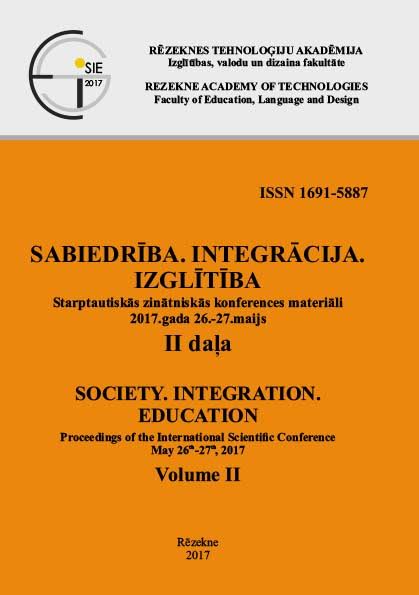THE THEORETICAL ASPECTS OF WELL-BEING IN THE CONTEXT OF LIFELONG LEARNING
DOI:
https://doi.org/10.17770/sie2017vol2.2376Keywords:
lifelong learning, life quality, well-beingAbstract
In 2006 the European Parliament and European Union Council has defined eight key competences for lifelong learning, necessary for personal fulfillment and development, active citizenship, social inclusion and employment. Since the economic crisis of 2008, the world is looking for new ways and methods to ensure the well-fare and reformulate the value of human life. Currently at EU level, one of the most important debates closely connected with the basic context of lifelong learning is on the dimensions of life quality. The desk study deals with the qualitative content analysis of the documents of EU, OECD, data of the projects of Office of National Statistics in Latvia, the U.K. and Germany, research of Ruff (1995), Rath and Harter (2010), Layard (2005), Rohr (2014), etc. The dimensions of life quality in different sources and by different authors have been defined similarly indicating that the qualitative indicators are as important as the quantitative. It is clear that the quality of life cannot be measured only by quantitative indicators such as income or birth / mortality. This article discusses the theoretical aspects of such dimension of life quality as well-being in different sources, compares and analyses them in the Latvian context.Downloads
References
Aristotelis (1985). Nikomaha ētika. Rīga: Zvaigzne.
Buhler, C. (1935). The Curve of Life as Studied in Biographies. Journal of Applied Psychology 19, 405-409
Boarini, R. Et al. (2016). Multi-dimensional Living Standards: A Welfare Measure Based on Preferences, OECD Statistics Working Papers, Paris: OECD Publishing
Brighouse, H. (2006). On Education. New York: Routledge
Centrālā statistikas pārvalde (2014). Dzīves kvalitātes sistēmas rādītāji. Pieejams: http://www.csb.gov.lv/statistikas-temas/dzives-kvalitates-sistemas-raditaji-39486.html
Die Bundesregierung (2016). Bericht der Bundesregierung zur Lebensqualitat in Deutschland. Berlin: Presse-und Informationsamt der Bundesregierung
Erikson, E. (1959). Identity and the Life Cycle. Psychological Issues, 1, 18-164
Eurostat (2011). Percentage of Population Assessing Whether Life is Worthwhile. Pieejams:
Eurostat (2011). Quality of Life Indicators. Pieejams: http://ec.europa.eu/eurostat/statistics-explained/index.php/Quality_of_life_indicators
Komenskis, J.A. (1992). Lielā didaktika. Rīga: Valsts izdevniecība “Zvaigzne”
Layard, R. (2005). Happiness: Lessons from a New Science. New York: Penguin Press
Neugarten, B.L. (1973). Personality Change in Late Life: A Developmental Perspective. //:In Eisdorfer,C. & Lawton, M.P. (Eds.) The Psychology of Adult Development and Aging. Washington, DC: American Psychological Association, 311-335
Noble, T., McGrath, H. (2015). PROSPER: A New Framework for Positive Education. Psychology of Well-Being.5:2, DOI 10.1186/s13612-015-0030-2
OECD (2013). Guidelines on Measuring Subjective Well-being OECD Publishing. Pieejams: https://www.oecd.org/statistics/Guidelines%20on%20Measuring%20Subjective%20Well-being.pdf
Rath, T., Harter J., (2010). The Economics of Well-being. Vieta: Gallup Press
Rors, R. (2014). Kritiens augšup. Rīga: Lietusdārzs, 31-41.
Ryff, D.C &Keyes, C.L.M. (1995). The Structure of Psychological Well-Being Revised. Journal of Personality and Social Psychology. Vol. 69, No.4, 719-727
Stiglitz J.E., Sen A., Fitoussi J.,P. The Measurement of Economic Performance and Social Progress Revised(2009) OFCE, No.2009-33 Pieejams: http://www.ofce.sciences-po.fr/pdf/dtravail/WP2009-33.pdf
Valsts prezidenta kanceleja (2006). Dzīves kvalitāte Latvijā. Rīga: Apgāds zinātne. Pieejams: http://www.president.lv/images/modules/items/PDF/item_1124_Dzives_kvalitaate_Latvija.pdf


